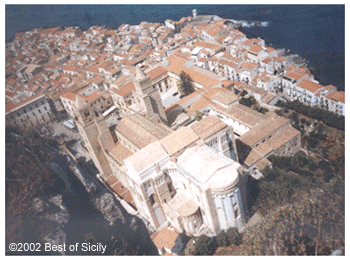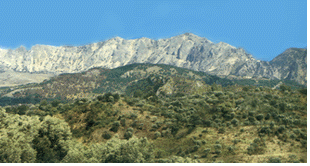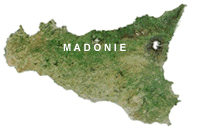
Sights • Localities • Cuisine • Tours • Hotels
Cefalù and the Madonie Mountains
Related pages: Cefalù's Cloister • Ancient & Medieval History • Timeline • Sicanians • Coasts • Beaches • Religions • Byzantines • Normans
![]() One of the Mediterranean's undiscovered jewels.
The epitome of picturesque grandeur. Good descriptions of this captivating seaside town in the shadow of a steep mountain. Cefalu has a beach,
winding, narrow, medieval streets, and
One of the Mediterranean's undiscovered jewels.
The epitome of picturesque grandeur. Good descriptions of this captivating seaside town in the shadow of a steep mountain. Cefalu has a beach,
winding, narrow, medieval streets, and  delightful restaurants overlooking a rocky coast. All under the everpresent gaze of the
Norman-Arab-Byzantine cathedral, one of the greatest churches of southern Europe. Nestled between the Madonie Mountains and the sea, Cefalù's
mountain boasts the ruins of a large fortress and an ancient Sicanian-Greek temple. The view
from the summit is inspiring.
delightful restaurants overlooking a rocky coast. All under the everpresent gaze of the
Norman-Arab-Byzantine cathedral, one of the greatest churches of southern Europe. Nestled between the Madonie Mountains and the sea, Cefalù's
mountain boasts the ruins of a large fortress and an ancient Sicanian-Greek temple. The view
from the summit is inspiring.
On the northern coast, 75 kilometers east of Palermo, from which it is about forty-five minutes by car, a bit longer on an express train, Cefalù (with the accent on the last syllable) is a medieval town built on the site of an ancient Sicanian and Greek settlement. In fact, its name derives from the Greek word for a cape; the ancient city was called Cephaloedion. Except for a few archeological items in a local museum (the Mandralisca), all that remains of these ancient cultures today is a small structure, the Temple of Diana, on the mountain overlooking the town. The foundation of this simple enclosure, a pseudo-trilithon, is said to be one of the oldest structures still standing in Sicily. Though the fortress itself crumbled long ago, the battlements atop the mountain were built during the Norman rule of the island in the eleventh and twelfth centuries. A few segments of this outer wall are restorations; most are original. For the stout hearted, the summit, with its magnificent view of the town, cathedral, mountains and sea, is well worth the climb. (Only Taormina's seaside view rivals this coastal vista.) Viewed at night from the shore to the west, the illuminated mountain and cathedral make for an inspiring site, evoking much of the city's medieval grandeur.
Begun in 1131 during the reign of Roger II, the cathedral and the adjoining
abbey and cloister (also open
to the public during limited hours) were completed by around 1150. The floor plan and artistic
style, typical of those of many cathedrals built in Northern Europe during
the same period (notably Saint Etienne), differ somewhat from the simple Romanesque lines of Monreale's
cathedral, especially when viewed from the outside. The church, with some Gothic features, was one
of the first Sicilian cathedrals built on the Western model, with a long nave and distinct transept. This indicates an influence more Norman than Byzantine
or Arab, though the icon of Christ in the apse leaves no doubt about the
Eastern (Orthodox) tradition still very much alive in western Sicily at
the time the church was built. Cefalù Cathedral lacks the  extensive
mosaics of Monreale; its ambience is altogether more Gothic than Byzantine,
though purists would point out that its style shows only partial signs of
early Gothic forms. Do keep in mind that the cathedral is closed in
the afternoon from 1 to 4.
extensive
mosaics of Monreale; its ambience is altogether more Gothic than Byzantine,
though purists would point out that its style shows only partial signs of
early Gothic forms. Do keep in mind that the cathedral is closed in
the afternoon from 1 to 4.
During the the War of the Vespers, Charles the Lame, son and heir of the King of Naples, was imprisoned in the citadel by the Aragonese following a naval defeat during the War of the Sicilian Vespers. While the royal visitor's imprisonment could not have lacked for splendid views or fine cuisine, one senses a certain isolation here. The prince survived his stay at Cefalù to be crowned Charles II of Naples upon his father's death in 1285, though his dynasty had to renounce their rights to Sicily in favor of the House of Aragon.
Near the ruins of the fortress at the top of the mountain are the remnants of the so-called Temple of Diana, probably a Sicanian structure. Its portal and cut stone reflect Greek and Roman construction, and in fact the cult of Hercules worshipped here. However, the temple's foundations are actually far more ancient, dating to the ninth century BC if not somewhat earlier.
Several medieval buildings still stand in the city itself. These include the lavatoio (lavandai), a medieval wash house fed by freshwater springs, and the Osteria Magna (Great Guesthouse), where King Roger stayed during his visits to Cefalù. A maze of charming medieval streets makes Cefalù a pleasant spot, whether you stay for a morning or an entire day.
The Mandralisca Museum is worth a visit. Its extensive collections of art, archeology and natural objects (sea shells) include a painting by Antonello da Messina.
High in the Madonie Mountains nearby, some 15 kilometers away, is Gibilmanna Sanctuary. The church itself is unremarkable but the wooded area surrounding it is beautiful.
Castelbuono, a mountain town about 20 kilometers from Cefalù, boasts a castle once owned by the Ventimiglia family, feudal lords of several towns in the area. Castelbuono is a charming locality in an attractive wooded location, though a bit remote for the casual traveler. Like Caccamo, Castelbuono (literally "good castle") has vestiges of medieval architecture, but its castle, which was modified somewhat over the centuries, is usually closed to the public.
For Visitors: There are some good restaurants in the town center and near the shore that offer seafood and other local specialties, and a number of pizzerias. You'll also find many small shops. Cefalù also has a nice public beach. As the cathedral and most museums are closed in the afternoon from 1 to 4, this is a perfect time to eat or go sunbathing. Finding parking space is difficult at times, but Cefalù is conveniently located on the Palermo-Messina railway, and most (though not all) trains traveling this line stop here. The train station is just a few steps from the centre of town. The Madonie Mountains (following section) are nearby.
Hotel Reservations are easy with the online reservation system on our travel planning page, where you'll find convenient links to information on flights, hotels, car rentals, restaurants, weather and even travel books.
Madonie Mountains
 Driving northward in Winter along the A-19 Palermo-Catania highway (autostrada) in the stretch near Polizzi Generosa and Caltavuturo, you pass a series of high rocky peaks usually covered with snow from late December until mid-March. It's the highest part of the Madonie range, and it's a majestic sight.
Driving northward in Winter along the A-19 Palermo-Catania highway (autostrada) in the stretch near Polizzi Generosa and Caltavuturo, you pass a series of high rocky peaks usually covered with snow from late December until mid-March. It's the highest part of the Madonie range, and it's a majestic sight.
The Madonie boast Pizzo Carbonara (Carbonara Peak, formerly Pizzo della Principessa), at 1979 meters (about 6000 feet) the highest point in Sicily after Mount Etna. Eagles and hawks soar overhead. The Madonie are an extension of the Nebrodi and Peloritan mountains to the east, and with them are part of a rugged chain extending through Italy across Calabria and Sicily and then into Tunisia. Many of the towns nestled into the Madonie are of Saracen Arab foundation, dating from around the ninth century, and were subsequently developed further into larger villages under the conquering Normans. Several are ancient, built upon the remains of Sicanian, Greek and Roman settlements.
The Madonie region extends, between the towns of Scillato and Castelbuono, from the Pollina to the Imera rivers, reaching down to the foothills visible from coastal Cefalù. The land itself is often wooded, and while few wild cats and no native deer remain, it is a beautiful area, especially in Winter. There are porcupines, foxes, hares, numerous birds of prey and some re-introduced deer. Among the native flora are the giant holly (some over three hundred years old), wild olives (oleasters), and the rare local variety of Madonian Spruce or "Sicilian Fir" (Abies Nebrodensis), as well as the flowering Manna Ash (Fraxinus Ornus).
Like many "micro-regions," the Madonie has its own cuisine, and a typically rural lifestyle. In recent decades, emigration has depleted the population of many of the hill towns, but  these scenic mountains remain popular with residents of Palermo seeking to escape from the city for a few days. It's a favorite area for hiking. At the Piano Battaglia resort, there's skiing for a few weeks in January and February. Indeed, these mountains are the only area in western Sicily where snow typically lasts for more than a few days. The Tiberio Gorge, formed from limestone erosion, on the Pollina River near San Mauro Castelverde, is one of the area's many attractions.
these scenic mountains remain popular with residents of Palermo seeking to escape from the city for a few days. It's a favorite area for hiking. At the Piano Battaglia resort, there's skiing for a few weeks in January and February. Indeed, these mountains are the only area in western Sicily where snow typically lasts for more than a few days. The Tiberio Gorge, formed from limestone erosion, on the Pollina River near San Mauro Castelverde, is one of the area's many attractions.
The "Madonie Park" is a protected reserve encompassing several townships, including Cefalù, Pollina, Castelbuono, Geraci Siculo, Petralia Soprana, Petralia Sottana, Polizzi Generosa, Sclafani Bagni, Caltavuturo and Collesano, as well as the villages of Gratteri, Isnello, San Mauro Castelverde, Scillato and Lascari. When the Normans fought several minor battles here in 1062-1063, the largest Saracen (Arab) Muslim towns were Kalat-Abi-Thur (Caltavuturo) and Petralia. The towns in the Nebrodi Mountains to the east were predominantly "Byzantine" settlements peopled by Greek Orthodox Christians before the arrival of the Arabs.
Home • Sights • Localities • Cuisine • Tours • Hotels
©1999-2025 Best of Sicily Travel, Palermo, Italy. All Rights reserved. You may prefer our desktop site on your tablet or computer.